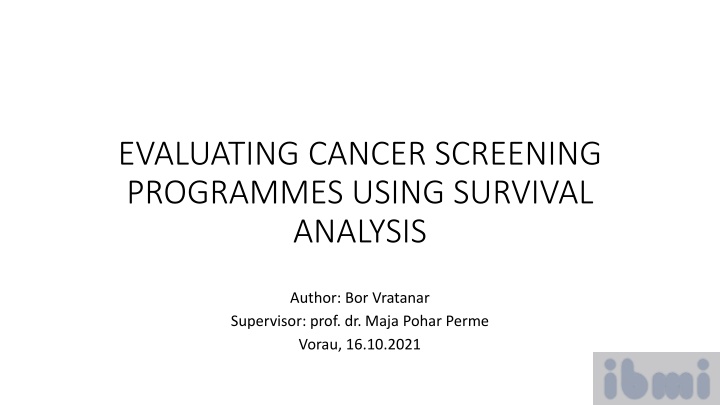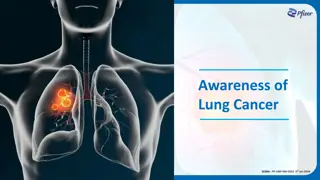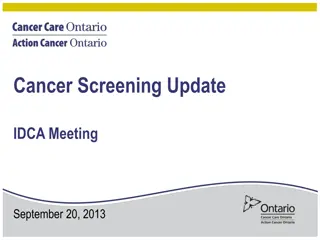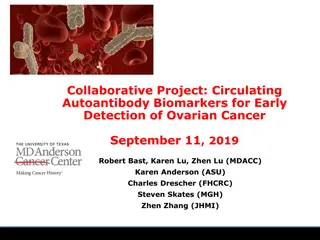Evaluating Cancer Screening Programmes Using Survival Analysis
This study explores the evaluation of cancer screening programmes through survival analysis. The purpose is to identify cancer in healthy populations to offer early treatment, under the hypothesis that early treatment leads to better outcomes. The process involves defining working hypotheses, establishing experimental and control groups, observing survival outcomes, and conducting statistical tests. Different scenarios, including hypothetical experiments and observational studies, are outlined to understand the impact of early treatment on cancer outcomes.
Download Presentation

Please find below an Image/Link to download the presentation.
The content on the website is provided AS IS for your information and personal use only. It may not be sold, licensed, or shared on other websites without obtaining consent from the author.If you encounter any issues during the download, it is possible that the publisher has removed the file from their server.
You are allowed to download the files provided on this website for personal or commercial use, subject to the condition that they are used lawfully. All files are the property of their respective owners.
The content on the website is provided AS IS for your information and personal use only. It may not be sold, licensed, or shared on other websites without obtaining consent from the author.
E N D
Presentation Transcript
EVALUATING CANCER SCREENING PROGRAMMES USING SURVIVAL ANALYSIS Author: Bor Vratanar Supervisor: prof. dr. Maja Pohar Perme Vorau, 16.10.2021
CSPs Evaluating CSPs Notation Estimation Aims CANCER SCREENING PROGRAMMES (CSPs) Purpose: identify cancer in an apparently healthy population so that early treatment can be offered Hypothesis: early treatment is more successful in treating cancer Example: breast CSP in Slovenia
CSPs Evaluating CSPs Notation Estimation Aims HOW DO CSPs WORK? NO CANCER ACCEPT INTERVAL CANCER INVITATION (whole population) SCREEN-DETECTED CANCER DECLINE Only screen-detected cancers can benefit from CSPs! CANCER NO CANCER
CSPs Evaluating CSPs Notation Estimation Aims EVALUATING CSPs 1. Define working hypothesis:
CSPs Evaluating CSPs Notation Estimation Aims EVALUATING CSPs 1. Define working hypothesis: early treatment is more successful in treating cancer compared to delayed treatment 2. Define appropriate experimental (EG) and control group (CG): EG: screen-detected cases treated at screen diagnosis (early treatment) CG: screen-detected cases treated at symptoms (delayed treatment) 3. Observe relevant outcomes: survival time 4. Estimate: estimate survival curves for the experimental and control group 5. Statistical test: use statistical test to compare experimental and control group
CSPs Evaluating CSPs Notation Estimation Aims HYPOTHETICAL EXPERIMENT NO CANCER ACCEPT INTERVAL CANCER INVITATION (whole population) SCREEN-DETECTED CANCER DECLINE TREAT AT SYMPTOMS TREAT AT SCREEN DIAGNOSIS CANCER NO CANCER
CSPs Evaluating CSPs Notation Estimation Aims OBSERVATIONAL STUDY NO CANCER ACCEPT INTERVAL CANCER INVITATION (whole population) SCREEN-DETECTED CANCER DECLINE TREAT AT SYMPTOMS TREAT AT SCREEN DIAGNOSIS CANCER NO CANCER
CSPs Evaluating CSPs Notation Estimation Aims OBSERVATIONAL STUDY NO CANCER ACCEPT INTERVAL CANCER INVITATION (whole population) SCREEN-DETECTED CANCER DECLINE TREAT AT SYMPTOMS TREAT AT SCREEN DIAGNOSIS CANCER NO CANCER
CSPs Evaluating CSPs Notation Estimation Aims ALTERNATIVE CG #1: INTERVAL CANCERS Interval cancers (treated at symptoms): a good choice for CG? Detection mode (interval vs screen-detected) Survival time Cancer growth speed
CSPs Evaluating CSPs Notation Estimation Aims ALTERNATIVE CG #2: DECLINE INVITATION Mixture of interval cases and screen-detected cases treated at symptoms that would be observed in another scenario We propose a new method that allows us to extract the hypothetical survival curve of screen-detected cases in this group Formal notation is needed
CSPs Evaluating CSPs Notation Estimation Aims NOTATION We adopt the notation of causal inference: Treatment values ? {0 = decline invitation,1 = accept invitation} Let ?? ?be the potential outcome with notation s(x) indicating the action of setting X to x. b+m Fixed values: a age at first screening test b age at last possible screening test m screening interval (in years)
CSPs Evaluating CSPs Notation Estimation Aims NOTATION Random variables: ?? age at death from other causes ? = min ??,? + ? Potential outcomes: D age at cancer diagnosis ?? age at death from cancer whether a cancer would be detected in s(x) by t ? ?? ? = min(??,?? ? ) ?? ? ? = ? ? ?? ?,?? ? < ? ?? 1 ?? 1 = 1 ?? 1 ?? 0 = 1 ?? 0 ?? 1 = 1 ?? 0 ?? 0 = 1
CSPs Evaluating CSPs Notation Estimation Aims NOTATION Random variables: ?? age at death from other causes ? = min ??,? + ? Potential outcomes: D age at cancer diagnosis ?? age at death from cancer whether a cancer would be detected in s(x) by t ? ?? ? = min(??,?? ? ) ?? ? ? = ? ? ?? ?,?? ? < ? ?? 1 ?? 1 = 1 ?? 1 ?? 0 = 1 ?? 0 ?? 1 = 0 ?? 0 ?? 0 = 1
CSPs Evaluating CSPs Notation Estimation Aims NOTATION Random variables: ?? age at death from other causes ? = min ??,? + ? Potential outcomes: D age at cancer diagnosis ?? age at death from cancer whether a cancer would be detected in s(x) by t ? ?? ? = min(??,?? ? ) ?? ? ? = ? ? ?? ?,?? ? < ? ?? 1 ?? 1 = 1 ?? 1 ?? 0 = 0 ?? 0 ?? 1 = 0 ?? 0 ?? 0 = 0
CSPs Evaluating CSPs Notation Estimation Aims NOTATION Random variables: ?? age at death from other causes ? = min ??,? + ? Potential outcomes: D age at cancer diagnosis ?? age at death from cancer whether a cancer would be detected in s(x) by t ? ?? ? = min(??,?? ? ) ?? ? ? = ? ? ?? ?,?? ? < ? ?? 1 ?? 1 = 1 ?? 1 ?? 0 = 0 ?? 0 ?? 1 = 0 ?? 0 ?? 0 = 0
CSPs Evaluating CSPs Notation Estimation Aims NOTATION Random variables: ?? age at death from other causes ? = min ??,? + ? Potential outcomes: D age at cancer diagnosis ?? age at death from cancer whether a cancer would be detected in s(x) by t ? ?? ? = min(??,?? ? ) ?? ? ? = ? ? ?? ?,?? ? < ? ?? 1 ?? 1 = 0 ?? 1 ?? 0 = 0 ?? 0 ?? 1 = 0 ?? 0 ?? 0 = 0
CSPs Evaluating CSPs Notation Estimation Aims CONTRAST S(? | ?? 1(?? 1) = 1,?? 0(?? 1) = 0,? 1 ,? > ?? 1) vs vs S(? | ?? 1(?? 1) = 1,?? 0(?? 1) = 0,? 0 ,? > ?? 1)
CSPs Evaluating CSPs Notation Estimation Aims ESTIMATION S(? | ?? 1(?? 1) = 1,?? 0(?? 1) = 0,? 1 ,? > ?? 1) S(? | ?? 1(?? 1) = 1,?? 0(?? 1) = 0,? 0 ,? > ?? 1)
CSPs Evaluating CSPs Notation Estimation Aims PROPOSED METHOD Assumptions: Assume that the patients in DG are the same with respect to cancer-related variables to the group of patients in AG Assume also that the two groups do not differ with respect to other cause mortality Consequently (based on the assumptions above): The proportion of interval (?2) and screen-detected cancers (?1) is the same between AG and DG ? ? AG,interval = ? ? DG,interval ?1+ ?2= 1 ? ? AG,cancer = ?1 ? ? AG,screen + ?2 ? ? AG,interval ?0= diagnosis ? ? DG,cancer = ?1 ? ? DG,screen + ?2 ? ? DG,interval Red = observed
CSPs Evaluating CSPs Notation Estimation Aims SOME PROBLEMS REMAIN Lead time bias: screen-detected cases are diagnosed with cancer at an earlier time in s(0) than in s(1) Selection bias: we might detect some (typically slow- growing) cancers in s(1) but not in s(0)
CSPs Evaluating CSPs Notation Estimation Aims PROPOSED METHOD 1. Estimate the number of missing cancer cases in DG 2. Impute age at diagnosis for missing cancer cases in DG 3. Estimate the distribution of lead time (L) via deconvolution: ???= ???+ ? 4. By sampling values from L: one can find overdetected and overdiagnosed cases in AG one can eliminate lead time bias 5. Extract the survival curve for screen-detected cases in DG 6. Compare the survival curve for screen-detected cases in DG and AG using bootstrap procedure
CSPs Evaluating CSPs Notation Estimation Aims AIMS Define and explore different sources of bias that occur when evaluating the effectiveness of CSPs. Develop a non-parametric methodology for evaluation of the effectiveness of CSPs. Examine the properties of the proposed method. Illustrate the proposed method using data from the Slovenian breast cancer screening programme DORA.























